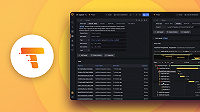S3Part
Open source
S3Part
S3Part is returned by the uploadPart(bucketName, objectKey, uploadId, partNumber, data) method when uploading a part to a multipart upload. The S3Part object describes an Amazon S3 Part.
| Name | Type | Description |
|---|---|---|
S3Part.partNumber | number | The S3 Part’number |
S3Part.eTag | String | The S3 Part’s etag |
Example
JavaScript
import crypto from 'k6/crypto';
import exec from 'k6/execution';
import {
AWSConfig,
S3Client,
} from 'https://jslib.k6.io/aws/0.13.0/s3.js';
const awsConfig = new AWSConfig({
region: __ENV.AWS_REGION,
accessKeyId: __ENV.AWS_ACCESS_KEY_ID,
secretAccessKey: __ENV.AWS_SECRET_ACCESS_KEY,
sessionToken: __ENV.AWS_SESSION_TOKEN,
});
const s3 = new S3Client(awsConfig);
const testBucketName = 'test-jslib-aws';
const testFileKey = 'multipart.txt';
export default async function () {
// Produce random bytes to upload of size ~12MB, that
// we will upload in two 6MB parts. This is done as the
// minimum part size supported by S3 is 5MB.
const bigFile = crypto.randomBytes(12 * 1024 * 1024);
// Initialize a multipart upload
const multipartUpload = await s3.createMultipartUpload(testBucketName, testFileKey);
// Upload the first part
const firstPartData = bigFile.slice(0, 6 * 1024 * 1024);
const firstPart = await s3.uploadPart(
testBucketName,
testFileKey,
multipartUpload.uploadId,
1,
firstPartData
);
// Upload the second part
const secondPartData = bigFile.slice(6 * 1024 * 1024, 12 * 1024 * 1024);
const secondPart = await s3.uploadPart(
testBucketName,
testFileKey,
multipartUpload.uploadId,
2,
secondPartData
);
// Complete the multipart upload
await s3.completeMultipartUpload(testBucketName, testFileKey, multipartUpload.uploadId, [
firstPart,
secondPart,
]);
// Let's redownload it verify it's correct, and delete it
const obj = await s3.getObject(testBucketName, testFileKey);
await s3.deleteObject(testBucketName, testFileKey);
}A k6 script that will upload a part in a multipart upload to an S3 bucket
Was this page helpful?
Related documentation
Related resources from Grafana Labs
Additional helpful documentation, links, and articles:
08 May

Without a trace (query): Troubleshooting simplified with Tempo and Traces Drilldown in Grafana
See how Traces Drilldown in Grafana, powered by Grafana Tempo, can simplify complex troubleshooting, helping you quickly detect latency issues, identify error trends, and spot anomalies – all without having to learn yet another query language.
60 min

Getting started with tracing and Grafana Tempo
In this webinar, we'll show you how to get started setting up Grafana Tempo, our open source, easy-to-use and high-volume distributed tracing backend.
60 min

Scaling your distributed tracing with Grafana Tempo
In this demo, we’ll show how Grafana Tempo allows you to scale tracing as far as possible with less operational cost and complexity than ever before.
